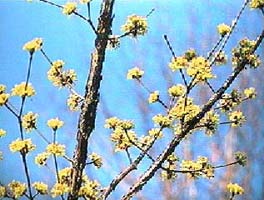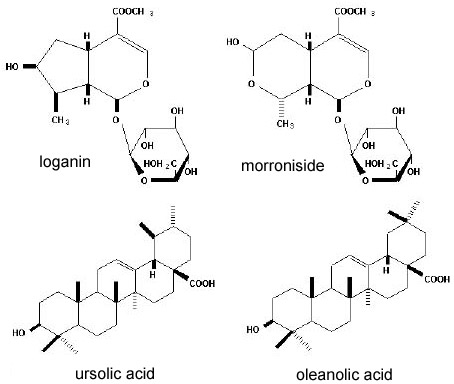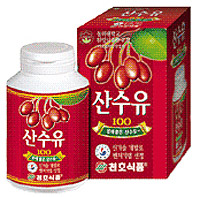
| The cornus tree, the Japanese dogwood or Japanese Cornelian Cherry, is a well-known decorative plant. Several different species are grown in the northern areas of America, Europe, and Asia. The trees most often used as a source of the Chinese herb are Cornus officinalis, which are cultivated for this purpose mainly in Henan, Zhejiang and Shaanxi provinces and are native to China, Korea, and Japan.
The plant produces a large amount of sour fruit in late autumn, which is collected when it turns red in color. The fruit is baked over a slow fire or treated with boiling water; the kernels are then removed and the fruit is sun-dried.
|


Cornus fruit on the vine (left) and dried (right).
The dried fruit is said to replenish the liver and kidney (referring to the yin essence) and restrain loss of essence. Indications for its use are internal wind syndromes associated with deficiency of liver, such as dizziness and tinnitus; symptoms of kidney qi deficiency, with soreness in the lower back and knees, impotence, frequent urination, and enuresis; and symptoms of uncontrolled discharge, such as excessive uterine bleeding, leukorrhea, or profuse sweating. It is considered slightly warm in nature, and is notably sour in taste. Although cornus is listed in the materia medica as an astringent, it rarely appears in formulas that are today classified as astringent formulas, appearing instead in tonic therapies. Typical dosage is 6-12 grams in decoction.
The sour taste is attributable to common fruit acids, including malic acid, tartaric acid, and gallic acid. There are two groups of active constituents that have been identified: iridoids (e.g., loganin, sweroside, morroniside; making up about 2.5% of the dried fruit) and triterpenoids (mainly oleanolic acid and ursolic acid, and the glycosides derived from these). In addition, there are astringent tannins (called cornus-tannins or cornusiins). The red color of the fruits is attributable to anthocyanins, which are known as potent antioxidants.

The iridoids loganin and morroniside (top)
and the pentacyclic triterpenoids ursolic acid and oleanolic acid (bottom)
Iridoids are common components of plants, but the iridoid glycosides are important active components of only certain Chinese herbs, particularly rehmannia, with which cornus is frequently combined. It is thought that the glucose molecule is cleaved in the digestive system to yield the aglycone as the active compound that has anti-inflammatory actions.
Oleanolic acid (OA) and ursolic acid (UA) are isomers; they have the same chemical formula. These two pentacyclic triterpenes are of interest to scientists because of their numerous biological activities. OA can lower blood sugar, a property attributed to cornus, which is listed among the Chinese herbs used for treating diabetes. UA and OA have liver-protecting and anti-inflammatory effects; cornus is used in some herb formulas for viral hepatitis and the anti-inflammatory effects may be one reason that cornus can be recommended for low back and knee pain associated with aging.

| In Korea, cornus fruit is a popular remedy for impotence. As an example, a product made from the combined extracts of cornus (49%), lycium (46%), and rubus (5%) fruits is widely distributed and promoted for this purpose (shown right, with cornus fruits featured on the label). The fruit and this formulation are also said to be useful for promoting beautiful complexion, so it is a product recommended for both men and women. In China, cornus wine and cornus liquor have been produced. The active components oleanolic acid and ursolic acid are now available in nearly pure form (e.g, 90% or more), though the source material is not cornus but ligustrum, a fruit that has a higher concentration of these active components.
|
May 2003




